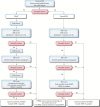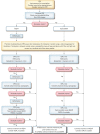2020 Korean Guidelines for Cardiopulmonary Resuscitation. Part 4. Adult advanced life support
- PMID: 34034448
- PMCID: PMC8171171
- DOI: 10.15441/ceem.21.023
2020 Korean Guidelines for Cardiopulmonary Resuscitation. Part 4. Adult advanced life support
Erratum in
-
Erratum to "2020 Korean Guidelines for Cardiopulmonary Resuscitation. Part 4. Adult advanced life support".Clin Exp Emerg Med. 2022 Jun;9(2):162-163. doi: 10.15441/ceem.21.023.e1. Epub 2022 Jun 30. Clin Exp Emerg Med. 2022. PMID: 35843620 Free PMC article. No abstract available.
Conflict of interest statement
No potential conflict of interest relevant to this article was reported.
Figures



References
-
- Panchal AR, Bartos JA, Cabanas JG, et al. Part 3: Adult Basic and Advanced Life Support: 2020 American Heart Association Guidelines for Cardiopulmonary Resuscitation and Emergency Cardiovascular Care. Circulation. 2020;(16_suppl_2):142. S366–468. - PubMed
-
- Morrison LJ, Gent LM, Lang E, et al. Part 2: Evidence Evaluation and Management of Conflicts of Interest: 2015 American Heart Association Guidelines Update for Cardiopulmonary Resuscitation and Emergency Cardiovascular Care. Circulation. 2015;132(18 Suppl 2):S368–82. - PubMed
-
- Perkins GD, Ji C, Deakin CD, et al. A randomized trial of epinephrine in out-of-hospital cardiac arrest. N Engl J Med. 2018;379:711–21. - PubMed
-
- Kudenchuk PJ, Brown SP, Daya M, et al. Amiodarone, lidocaine, or placebo in out-of-hospital cardiac arrest. N Engl J Med. 2016;374:1711–22. - PubMed
Publication types
Grants and funding
LinkOut - more resources
Full Text Sources
Other Literature Sources

